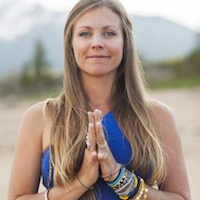Begin in Tadasana, Mountain Pose.
Lift the right leg, bend the knee and place the ankle right above the left knee in a figure 4 shape.
Flex the foot and keep it active. Bend the left knee until you’re in half chair, bring your hands to your heart and take a few breaths here. Think about lengthening your tailbone towards your heels, drawing the low belly in and lengthening up through the crown of the head.
From here, fold forward.
Place your palms down shoulder width apart, spread your fingers wide and keep the creases of your wrist in line with the top of your yoga mat (unless you’re in the grass, then just focus on keeping the index finger pointing forward).
Shift your weight forward until you can get the right knee high on top of the back of the right arm (the higher the better but this depends on how open your hips are).
Now this is key: hook the top of the right foot around the upper left arm and clamp there it tightly—this action is what keeps the pose together after take off!
Widen through the collar bones, spread your shoulder blades wide and soften the neck.
Bring all of your weight into the hands until you feel the left foot becoming lighter. This may be a great place to just gang out—focus on your alignment and your breathing and don’t go any further than your body allows you to. You want to be comfortable here!
When you’re ready, lift the left foot off the ground, press the thumb and the index finger down and feel the triceps hugging in. Once you are balancing on your hands, extend the left leg up and back behind you, trying to not open up through the hips here but keeping everything squared with the shoulders.
Breathe! Come down the same way you came in and then switch sides.
Be careful not to push your shoulders up to your ears when your balancing on your hands, and make sure your knees are happy throughout every step of this pose. If you ever feel your knees talking to you—back off!
This pose is to be practiced only at the end of your practice when your body is nice and warm and you’ve done plenty of hip opening and core work to prepare.
Listen to your body and remember: you’re here to breathe and connect.
Like elephant yoga on Facebook.
Ed: Bryonie Wise










Read 1 comment and reply